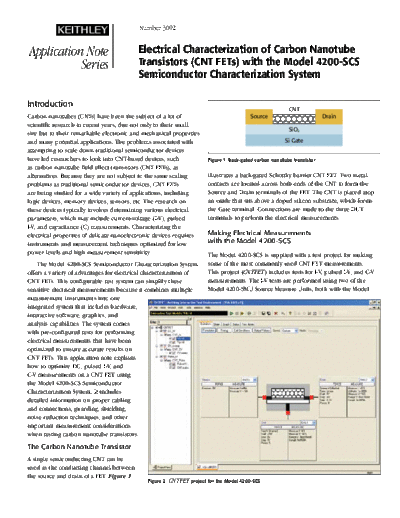Service Manuals, User Guides, Schematic Diagrams or docs for : Keithley Appnotes Carbon_Nanotube_AppNote
<< Back | HomeMost service manuals and schematics are PDF files, so You will need Adobre Acrobat Reader to view : Acrobat Download Some of the files are DjVu format. Readers and resources available here : DjVu Resources
For the compressed files, most common are zip and rar. Please, extract files with Your favorite compression software ( WinZip, WinRAR ... ) before viewing. If a document has multiple parts, You should download all, before extracting.
Good luck. Repair on Your own risk. Make sure You know what You are doing.
Image preview - the first page of the document

>> Download Carbon_Nanotube_AppNote documenatation <<
Text preview - extract from the document
Number 3092
Application Note Electrical Characterization of Carbon Nanotube
Series Transistors (CNT FETs) with the Model 4200-SCS
Semiconductor Characterization System
Introduction CNT
Carbon nanotubes (CNTs) have been the subject of a lot of Source Drain
scientific research in recent years, due not only to their small
SiO2
size but to their remarkable electronic and mechanical properties
and many potential applications. The problems associated with Si Gate
attempting to scale down traditional semiconductor devices
have led researchers to look into CNT-based devices, such Figure 1. Back-gated carbon nanotube transistor
as carbon nanotube field effect transistors (CNT FETs), as
alternatives. Because they are not subject to the same scaling illustrates a back-gated Schottky barrier CNT FET. Two metal
problems as traditional semiconductor devices, CNT FETs contacts are located across both ends of the CNT to form the
are being studied for a wide variety of applications, including Source and Drain terminals of the FET. The CNT is placed atop
logic devices, memory devices, sensors, etc. The research on an oxide that sits above a doped silicon substrate, which forms
these devices typically involves determining various electrical the Gate terminal. Connections are made to the three DUT
parameters, which may include current-voltage (I-V), pulsed terminals to perform the electrical measurements.
I-V, and capacitance (C) measurements. Characterizing the
electrical properties of delicate nanoelectronic devices requires Making Electrical Measurements
instruments and measurement techniques optimized for low with the Model 4200-SCS
power levels and high measurement sensitivity. The Model 4200-SCS is supplied with a test project for making
The Model 4200-SCS Semiconductor Characterization System some of the most commonly used CNT FET measurements.
offers a variety of advantages for electrical characterization of This project (CNTFET) includes tests for I-V, pulsed I-V, and C-V
CNT FETs. This configurable test system can simplify these measurements. The I-V tests are performed using two of the
sensitive electrical measurements because it combines multiple Model 4200-SMU Source Measure Units, both with the Model
measurement instruments into one
integrated system that includes hardware,
interactive software, graphics, and
analysis capabilities. The system comes
with pre-configured tests for performing
electrical measurements that have been
optimized to ensure accurate results on
CNT FETs. This application note explains
how to optimize DC, pulsed I-V, and
C-V measurements on a CNT FET using
the Model 4200-SCS Semiconductor
Characterization System. It includes
detailed information on proper cabling
and connections, guarding, shielding,
noise reduction techniques, and other
important measurement considerations
when testing carbon nanotube transistors.
The Carbon Nanotube Transistor
A single semiconducting CNT can be
used as the conducting channel between
the source and drain of a FET. Figure 1
Figure 2. CNTFET project for the Model 4200-SCS
4200-PA Preamp option. The pulsed and
transient I-V measurements are made
using the Model 4225-PMU Ultra Fast CNT
Source Drain
I-V Module with two Model 4225-RPM
Remote/Preamplifier Switch options. SiO2
Finally, the C-V measurements are Si Gate
performed using the Model 4210-CVU C-V
Measurement module.
The CNTFET project is included with Ground Unit A SMU1 A SMU2
or SMU3 Steps V Sweeps V
all Model 4200-SCS systems running (if required) Measures I
KTEI Version 8.1 or later. Figure 2 shows
the CNTFET project running in the
Keithley Interactive Test Environment
(KITE) software.
Current-Voltage Figure 3. Circuit diagram for measuring the DC I-V characteristics of a CNT FET
Measurements
The I-V characteristics of a CNT transistor
can be used to extract many of the
device's parameters, study the effects
of fabrication technique and process
variations, determine the quality of the
contacts, etc. Figure 3 illustrates a DC I-V
test configuration that incorporates two
Model 4200-SMUs (Source Measure Units).
These SMUs are capable of sourcing and
measuring both current and voltage;
they have picoamp sensitivity and can
be current-limited to prevent damage
to the device. In this diagram, SMU1 is
connected to the Gate of the CNT FET
and SMU2 is connected to the Drain.
The Source terminal is connected to the
Ground Unit (GNDU) or to a third SMU if
it is necessary to source and measure from
all three terminals of the FET.
In this example, the Model 4200-SCS's
KITE software is set up to measure a DC Figure 4. DC I-V drain family of curves measured by the Model 4200-SMU Source Measure Unit
drain family of curves (Vds◦ Jabse Service Manual Search 2024 ◦ Jabse Pravopis ◦ onTap.bg ◦ Other service manual resources online : Fixya ◦ eServiceinfo